Exploring Islamic Ideology, Rituals & Architecture Manifestations
VerifiedAdded on 2023/04/23
|34
|7519
|72
Thesis and Dissertation
AI Summary
This dissertation investigates the profound impact of Islamic ideology and rituals on spatial manifestations within architecture. It addresses the historical perception of Islamic architecture as a tradition that has waned in creativity due to modernization, and seeks to develop a methodological perspective that acknowledges both its internal cohesiveness and regional diversity. The study examines various forms in Islamic architecture, including mosques, the quibla wall, mihrab, minbar, domes, and madrasas, analyzing their functions and underlying meanings. It also explores the use of surface patterns, light, muqarnas, calligraphy, and geometry as expressions of Islamic ideology. Through a review of secondary sources and case studies, the dissertation concludes that Islamic ideology and rituals significantly influence the design and architecture of religious and other Islamic buildings, particularly mosques, highlighting the close relationship between religion and art in shaping spatial environments.
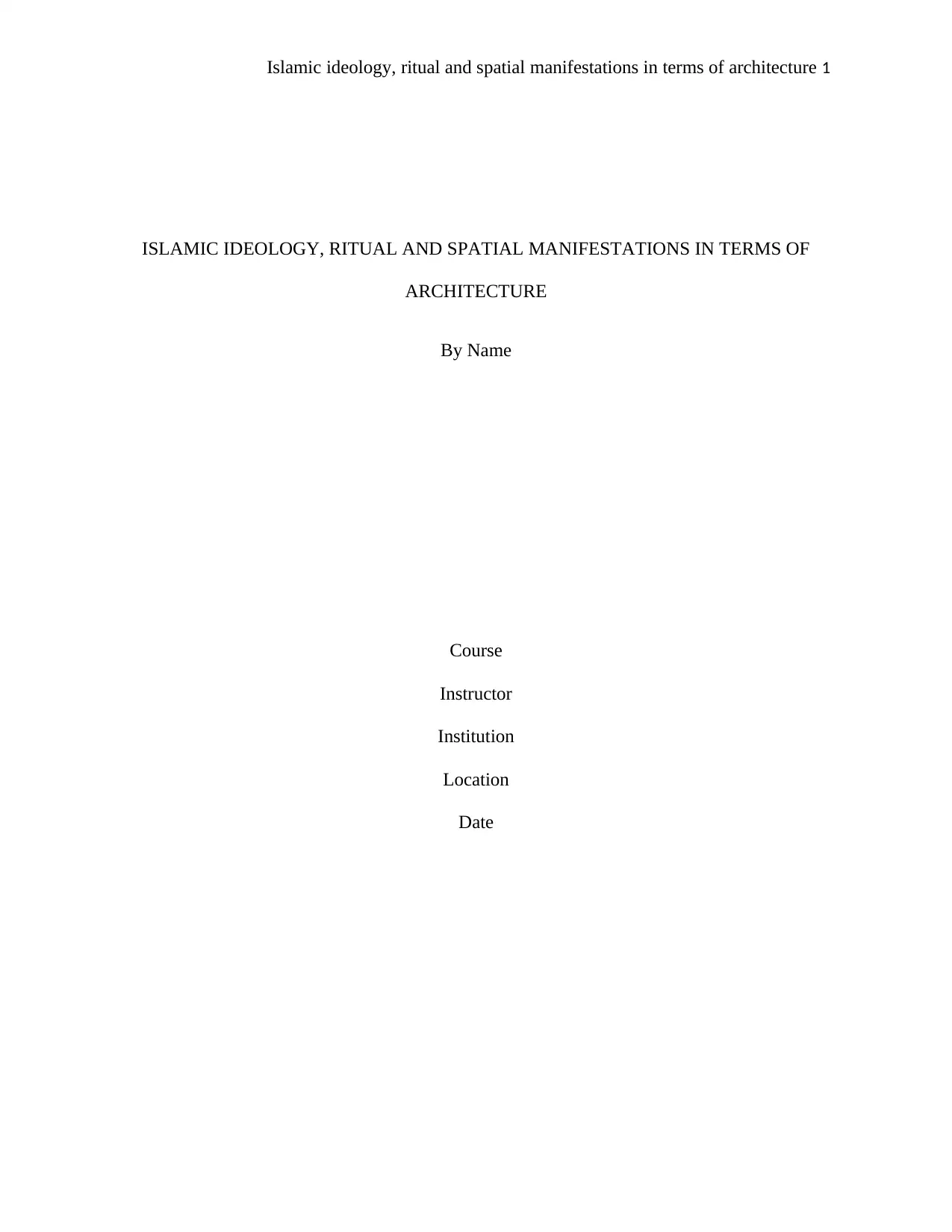
Islamic ideology, ritual and spatial manifestations in terms of architecture 1
ISLAMIC IDEOLOGY, RITUAL AND SPATIAL MANIFESTATIONS IN TERMS OF
ARCHITECTURE
By Name
Course
Instructor
Institution
Location
Date
ISLAMIC IDEOLOGY, RITUAL AND SPATIAL MANIFESTATIONS IN TERMS OF
ARCHITECTURE
By Name
Course
Instructor
Institution
Location
Date
Paraphrase This Document
Need a fresh take? Get an instant paraphrase of this document with our AI Paraphraser
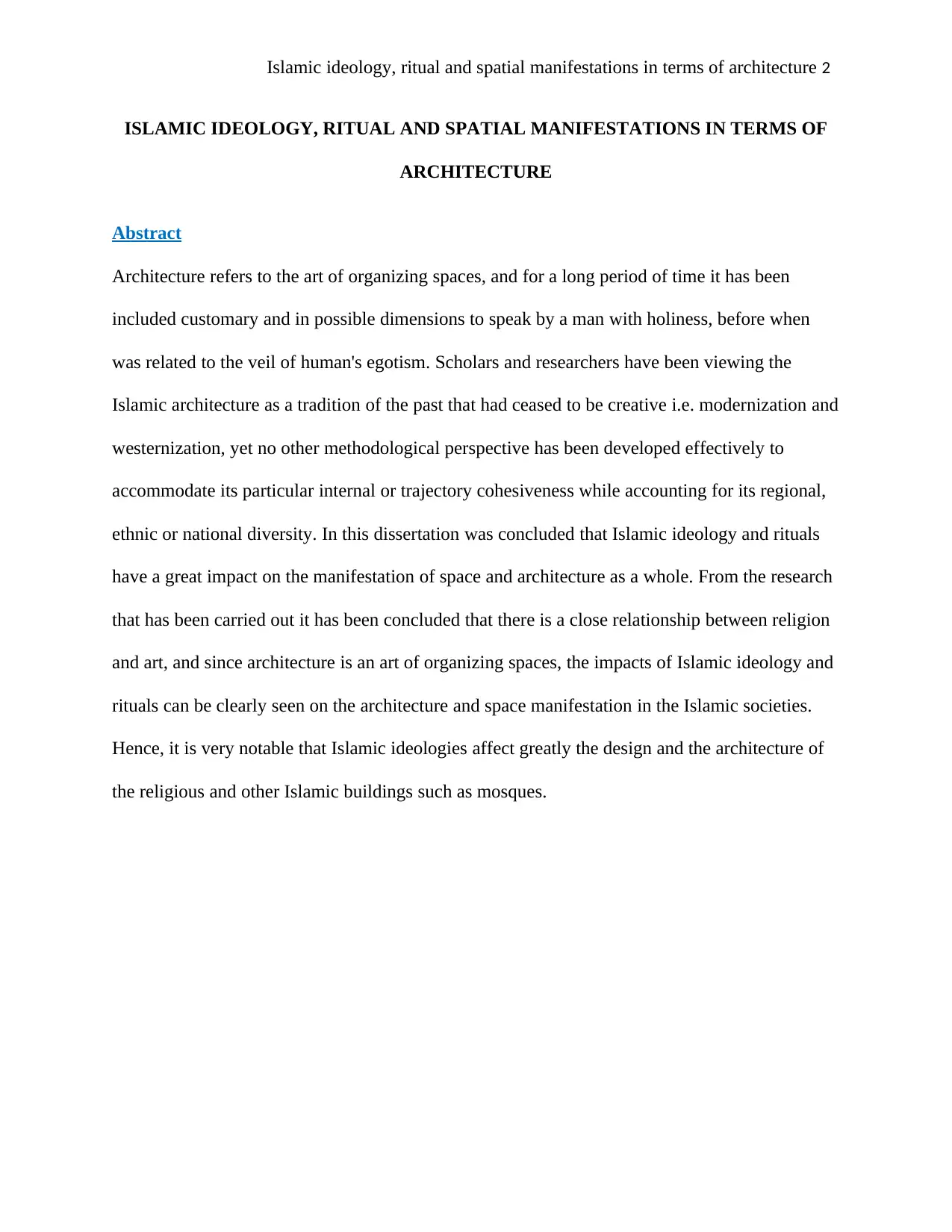
Islamic ideology, ritual and spatial manifestations in terms of architecture 2
ISLAMIC IDEOLOGY, RITUAL AND SPATIAL MANIFESTATIONS IN TERMS OF
ARCHITECTURE
Abstract
Architecture refers to the art of organizing spaces, and for a long period of time it has been
included customary and in possible dimensions to speak by a man with holiness, before when
was related to the veil of human's egotism. Scholars and researchers have been viewing the
Islamic architecture as a tradition of the past that had ceased to be creative i.e. modernization and
westernization, yet no other methodological perspective has been developed effectively to
accommodate its particular internal or trajectory cohesiveness while accounting for its regional,
ethnic or national diversity. In this dissertation was concluded that Islamic ideology and rituals
have a great impact on the manifestation of space and architecture as a whole. From the research
that has been carried out it has been concluded that there is a close relationship between religion
and art, and since architecture is an art of organizing spaces, the impacts of Islamic ideology and
rituals can be clearly seen on the architecture and space manifestation in the Islamic societies.
Hence, it is very notable that Islamic ideologies affect greatly the design and the architecture of
the religious and other Islamic buildings such as mosques.
ISLAMIC IDEOLOGY, RITUAL AND SPATIAL MANIFESTATIONS IN TERMS OF
ARCHITECTURE
Abstract
Architecture refers to the art of organizing spaces, and for a long period of time it has been
included customary and in possible dimensions to speak by a man with holiness, before when
was related to the veil of human's egotism. Scholars and researchers have been viewing the
Islamic architecture as a tradition of the past that had ceased to be creative i.e. modernization and
westernization, yet no other methodological perspective has been developed effectively to
accommodate its particular internal or trajectory cohesiveness while accounting for its regional,
ethnic or national diversity. In this dissertation was concluded that Islamic ideology and rituals
have a great impact on the manifestation of space and architecture as a whole. From the research
that has been carried out it has been concluded that there is a close relationship between religion
and art, and since architecture is an art of organizing spaces, the impacts of Islamic ideology and
rituals can be clearly seen on the architecture and space manifestation in the Islamic societies.
Hence, it is very notable that Islamic ideologies affect greatly the design and the architecture of
the religious and other Islamic buildings such as mosques.
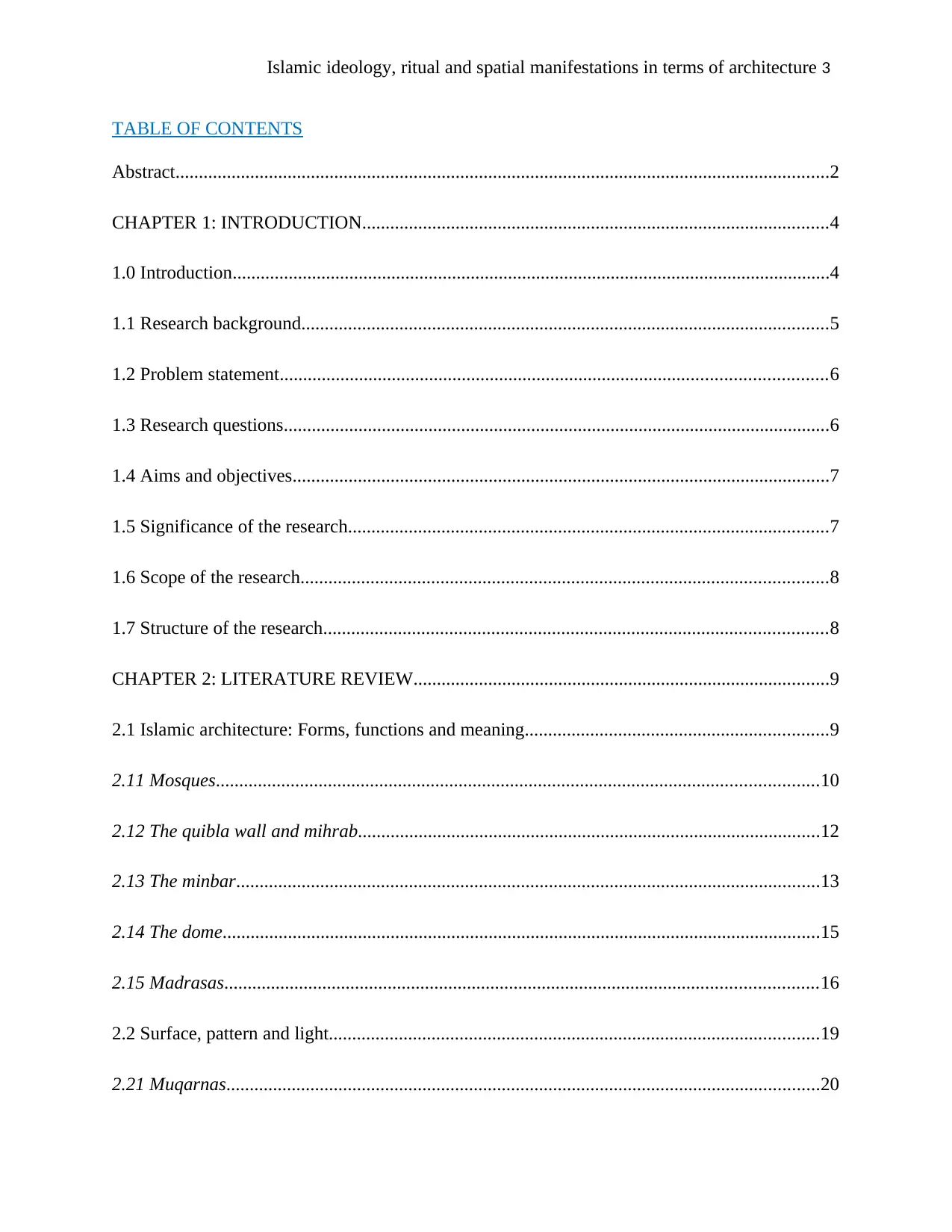
Islamic ideology, ritual and spatial manifestations in terms of architecture 3
TABLE OF CONTENTS
Abstract............................................................................................................................................2
CHAPTER 1: INTRODUCTION....................................................................................................4
1.0 Introduction................................................................................................................................4
1.1 Research background.................................................................................................................5
1.2 Problem statement.....................................................................................................................6
1.3 Research questions.....................................................................................................................6
1.4 Aims and objectives...................................................................................................................7
1.5 Significance of the research.......................................................................................................7
1.6 Scope of the research.................................................................................................................8
1.7 Structure of the research............................................................................................................8
CHAPTER 2: LITERATURE REVIEW.........................................................................................9
2.1 Islamic architecture: Forms, functions and meaning.................................................................9
2.11 Mosques.................................................................................................................................10
2.12 The quibla wall and mihrab...................................................................................................12
2.13 The minbar.............................................................................................................................13
2.14 The dome................................................................................................................................15
2.15 Madrasas...............................................................................................................................16
2.2 Surface, pattern and light.........................................................................................................19
2.21 Muqarnas...............................................................................................................................20
TABLE OF CONTENTS
Abstract............................................................................................................................................2
CHAPTER 1: INTRODUCTION....................................................................................................4
1.0 Introduction................................................................................................................................4
1.1 Research background.................................................................................................................5
1.2 Problem statement.....................................................................................................................6
1.3 Research questions.....................................................................................................................6
1.4 Aims and objectives...................................................................................................................7
1.5 Significance of the research.......................................................................................................7
1.6 Scope of the research.................................................................................................................8
1.7 Structure of the research............................................................................................................8
CHAPTER 2: LITERATURE REVIEW.........................................................................................9
2.1 Islamic architecture: Forms, functions and meaning.................................................................9
2.11 Mosques.................................................................................................................................10
2.12 The quibla wall and mihrab...................................................................................................12
2.13 The minbar.............................................................................................................................13
2.14 The dome................................................................................................................................15
2.15 Madrasas...............................................................................................................................16
2.2 Surface, pattern and light.........................................................................................................19
2.21 Muqarnas...............................................................................................................................20
⊘ This is a preview!⊘
Do you want full access?
Subscribe today to unlock all pages.

Trusted by 1+ million students worldwide
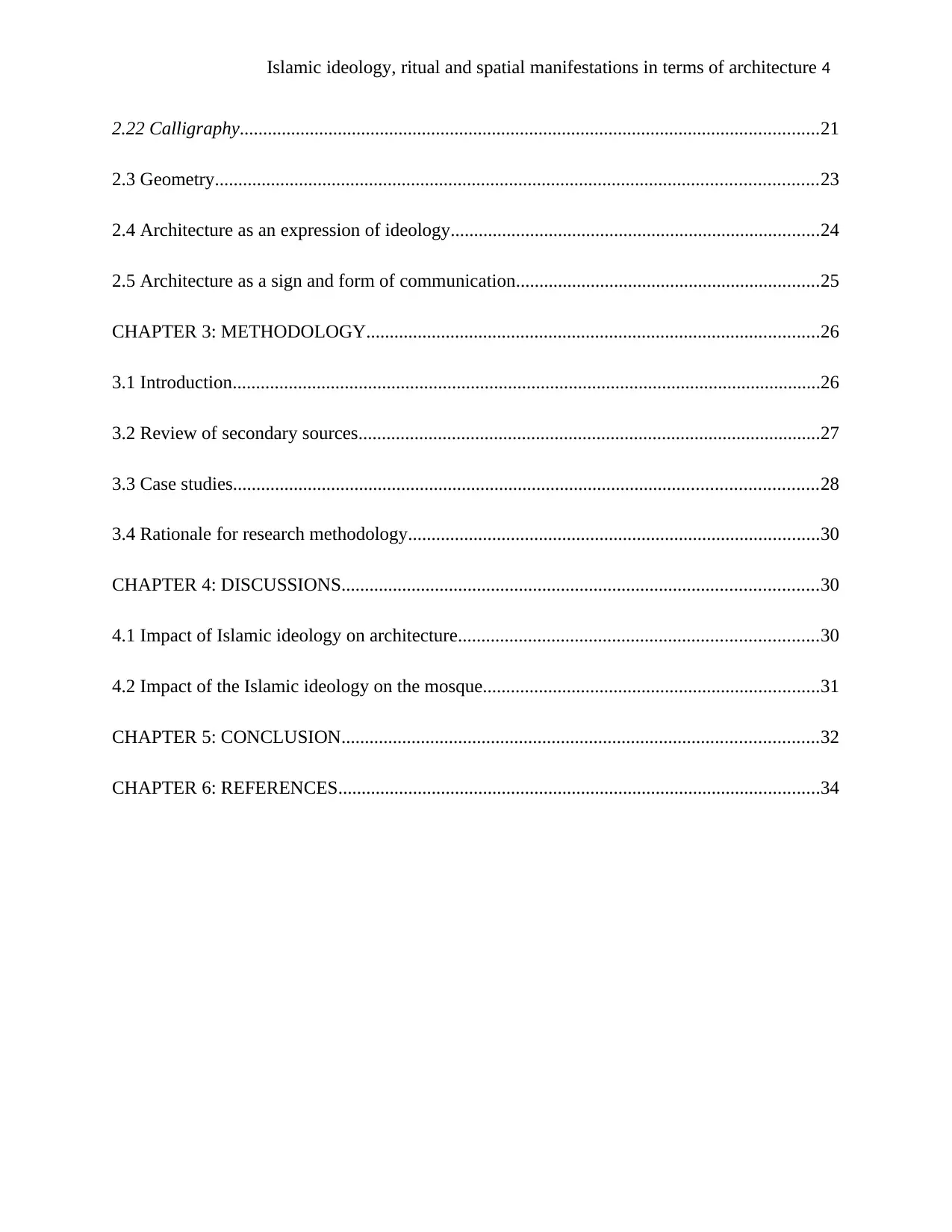
Islamic ideology, ritual and spatial manifestations in terms of architecture 4
2.22 Calligraphy............................................................................................................................21
2.3 Geometry.................................................................................................................................23
2.4 Architecture as an expression of ideology...............................................................................24
2.5 Architecture as a sign and form of communication.................................................................25
CHAPTER 3: METHODOLOGY.................................................................................................26
3.1 Introduction..............................................................................................................................26
3.2 Review of secondary sources...................................................................................................27
3.3 Case studies.............................................................................................................................28
3.4 Rationale for research methodology........................................................................................30
CHAPTER 4: DISCUSSIONS......................................................................................................30
4.1 Impact of Islamic ideology on architecture.............................................................................30
4.2 Impact of the Islamic ideology on the mosque........................................................................31
CHAPTER 5: CONCLUSION......................................................................................................32
CHAPTER 6: REFERENCES.......................................................................................................34
2.22 Calligraphy............................................................................................................................21
2.3 Geometry.................................................................................................................................23
2.4 Architecture as an expression of ideology...............................................................................24
2.5 Architecture as a sign and form of communication.................................................................25
CHAPTER 3: METHODOLOGY.................................................................................................26
3.1 Introduction..............................................................................................................................26
3.2 Review of secondary sources...................................................................................................27
3.3 Case studies.............................................................................................................................28
3.4 Rationale for research methodology........................................................................................30
CHAPTER 4: DISCUSSIONS......................................................................................................30
4.1 Impact of Islamic ideology on architecture.............................................................................30
4.2 Impact of the Islamic ideology on the mosque........................................................................31
CHAPTER 5: CONCLUSION......................................................................................................32
CHAPTER 6: REFERENCES.......................................................................................................34
Paraphrase This Document
Need a fresh take? Get an instant paraphrase of this document with our AI Paraphraser
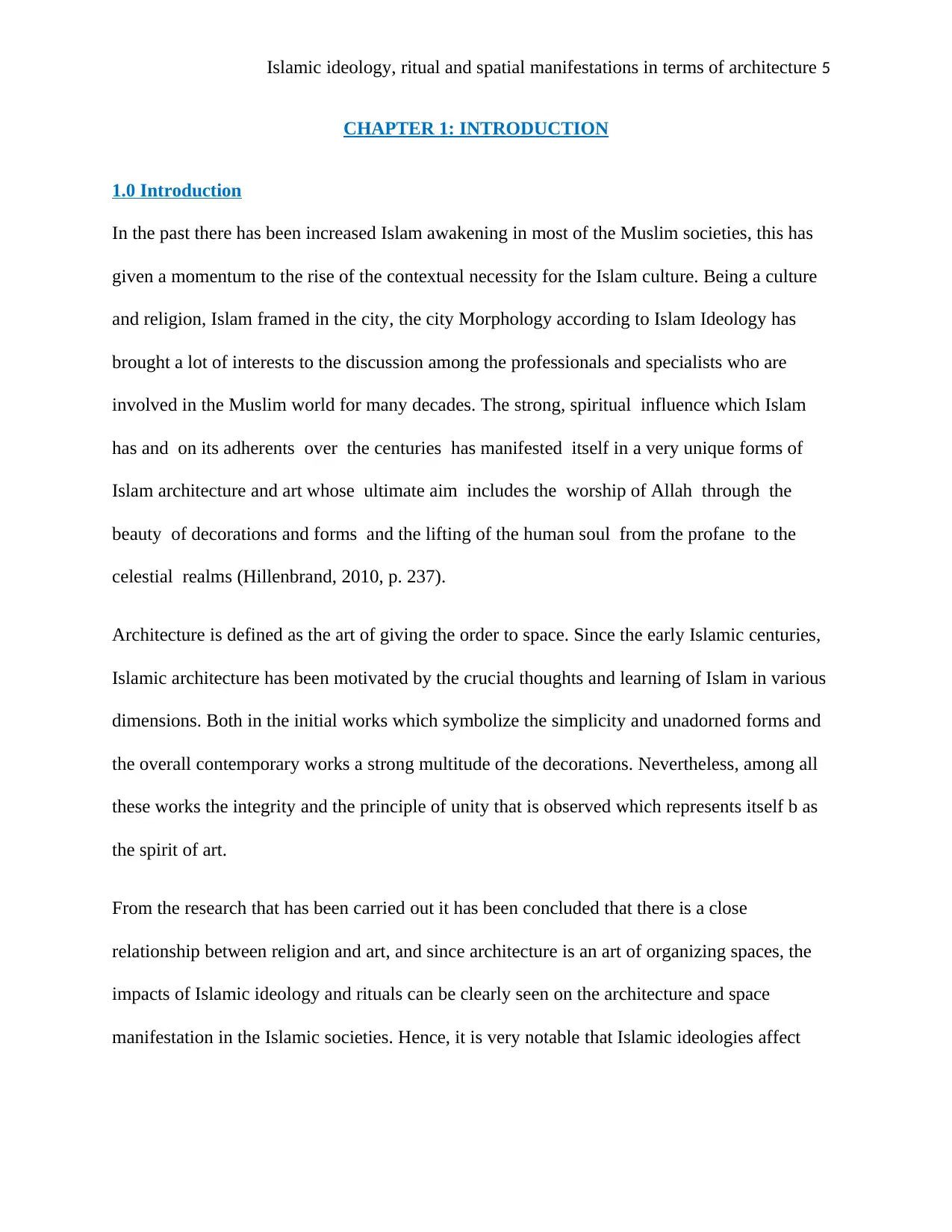
Islamic ideology, ritual and spatial manifestations in terms of architecture 5
CHAPTER 1: INTRODUCTION
1.0 Introduction
In the past there has been increased Islam awakening in most of the Muslim societies, this has
given a momentum to the rise of the contextual necessity for the Islam culture. Being a culture
and religion, Islam framed in the city, the city Morphology according to Islam Ideology has
brought a lot of interests to the discussion among the professionals and specialists who are
involved in the Muslim world for many decades. The strong, spiritual influence which Islam
has and on its adherents over the centuries has manifested itself in a very unique forms of
Islam architecture and art whose ultimate aim includes the worship of Allah through the
beauty of decorations and forms and the lifting of the human soul from the profane to the
celestial realms (Hillenbrand, 2010, p. 237).
Architecture is defined as the art of giving the order to space. Since the early Islamic centuries,
Islamic architecture has been motivated by the crucial thoughts and learning of Islam in various
dimensions. Both in the initial works which symbolize the simplicity and unadorned forms and
the overall contemporary works a strong multitude of the decorations. Nevertheless, among all
these works the integrity and the principle of unity that is observed which represents itself b as
the spirit of art.
From the research that has been carried out it has been concluded that there is a close
relationship between religion and art, and since architecture is an art of organizing spaces, the
impacts of Islamic ideology and rituals can be clearly seen on the architecture and space
manifestation in the Islamic societies. Hence, it is very notable that Islamic ideologies affect
CHAPTER 1: INTRODUCTION
1.0 Introduction
In the past there has been increased Islam awakening in most of the Muslim societies, this has
given a momentum to the rise of the contextual necessity for the Islam culture. Being a culture
and religion, Islam framed in the city, the city Morphology according to Islam Ideology has
brought a lot of interests to the discussion among the professionals and specialists who are
involved in the Muslim world for many decades. The strong, spiritual influence which Islam
has and on its adherents over the centuries has manifested itself in a very unique forms of
Islam architecture and art whose ultimate aim includes the worship of Allah through the
beauty of decorations and forms and the lifting of the human soul from the profane to the
celestial realms (Hillenbrand, 2010, p. 237).
Architecture is defined as the art of giving the order to space. Since the early Islamic centuries,
Islamic architecture has been motivated by the crucial thoughts and learning of Islam in various
dimensions. Both in the initial works which symbolize the simplicity and unadorned forms and
the overall contemporary works a strong multitude of the decorations. Nevertheless, among all
these works the integrity and the principle of unity that is observed which represents itself b as
the spirit of art.
From the research that has been carried out it has been concluded that there is a close
relationship between religion and art, and since architecture is an art of organizing spaces, the
impacts of Islamic ideology and rituals can be clearly seen on the architecture and space
manifestation in the Islamic societies. Hence, it is very notable that Islamic ideologies affect
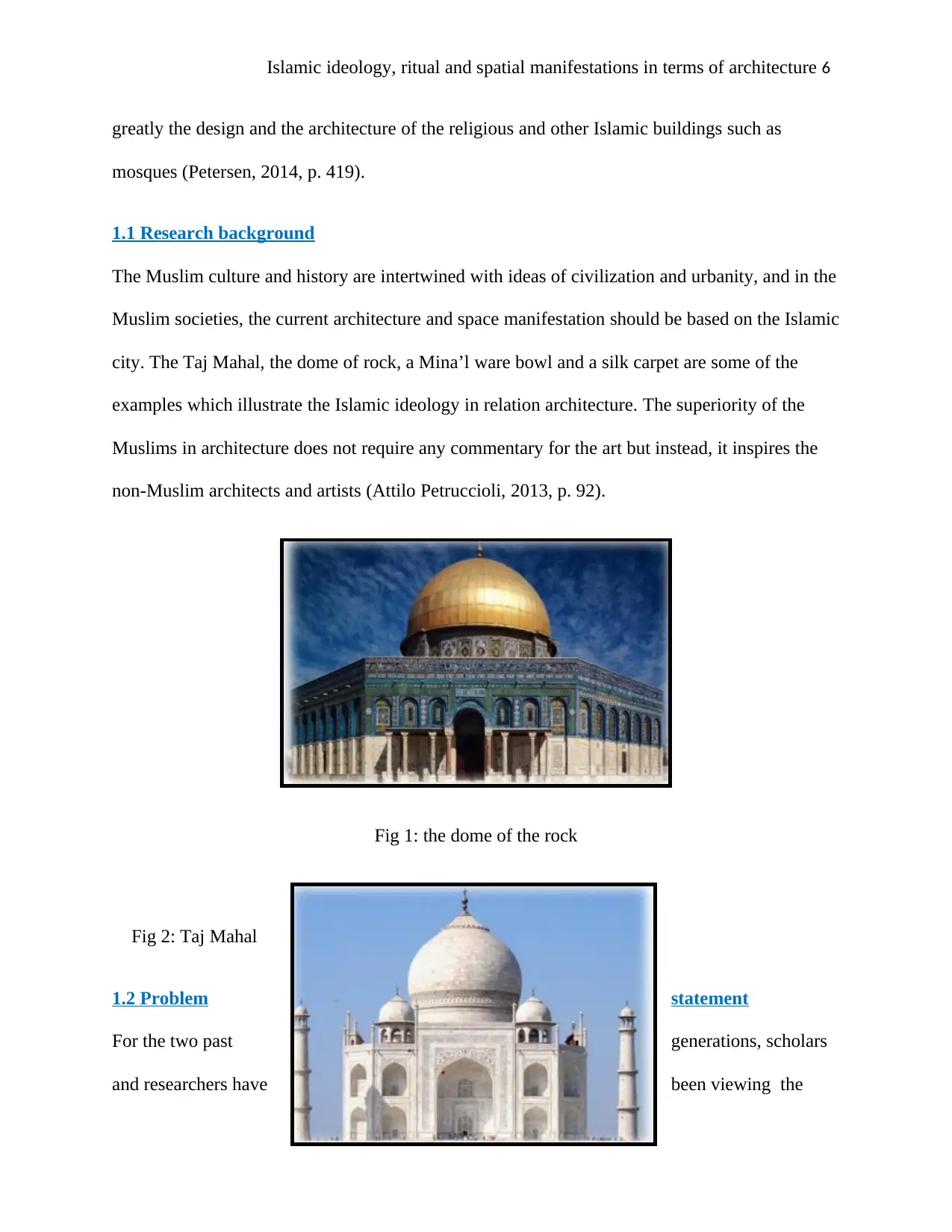
Islamic ideology, ritual and spatial manifestations in terms of architecture 6
greatly the design and the architecture of the religious and other Islamic buildings such as
mosques (Petersen, 2014, p. 419).
1.1 Research background
The Muslim culture and history are intertwined with ideas of civilization and urbanity, and in the
Muslim societies, the current architecture and space manifestation should be based on the Islamic
city. The Taj Mahal, the dome of rock, a Mina’l ware bowl and a silk carpet are some of the
examples which illustrate the Islamic ideology in relation architecture. The superiority of the
Muslims in architecture does not require any commentary for the art but instead, it inspires the
non-Muslim architects and artists (Attilo Petruccioli, 2013, p. 92).
Fig 1: the dome of the rock
Fig 2: Taj Mahal
1.2 Problem statement
For the two past generations, scholars
and researchers have been viewing the
greatly the design and the architecture of the religious and other Islamic buildings such as
mosques (Petersen, 2014, p. 419).
1.1 Research background
The Muslim culture and history are intertwined with ideas of civilization and urbanity, and in the
Muslim societies, the current architecture and space manifestation should be based on the Islamic
city. The Taj Mahal, the dome of rock, a Mina’l ware bowl and a silk carpet are some of the
examples which illustrate the Islamic ideology in relation architecture. The superiority of the
Muslims in architecture does not require any commentary for the art but instead, it inspires the
non-Muslim architects and artists (Attilo Petruccioli, 2013, p. 92).
Fig 1: the dome of the rock
Fig 2: Taj Mahal
1.2 Problem statement
For the two past generations, scholars
and researchers have been viewing the
⊘ This is a preview!⊘
Do you want full access?
Subscribe today to unlock all pages.

Trusted by 1+ million students worldwide
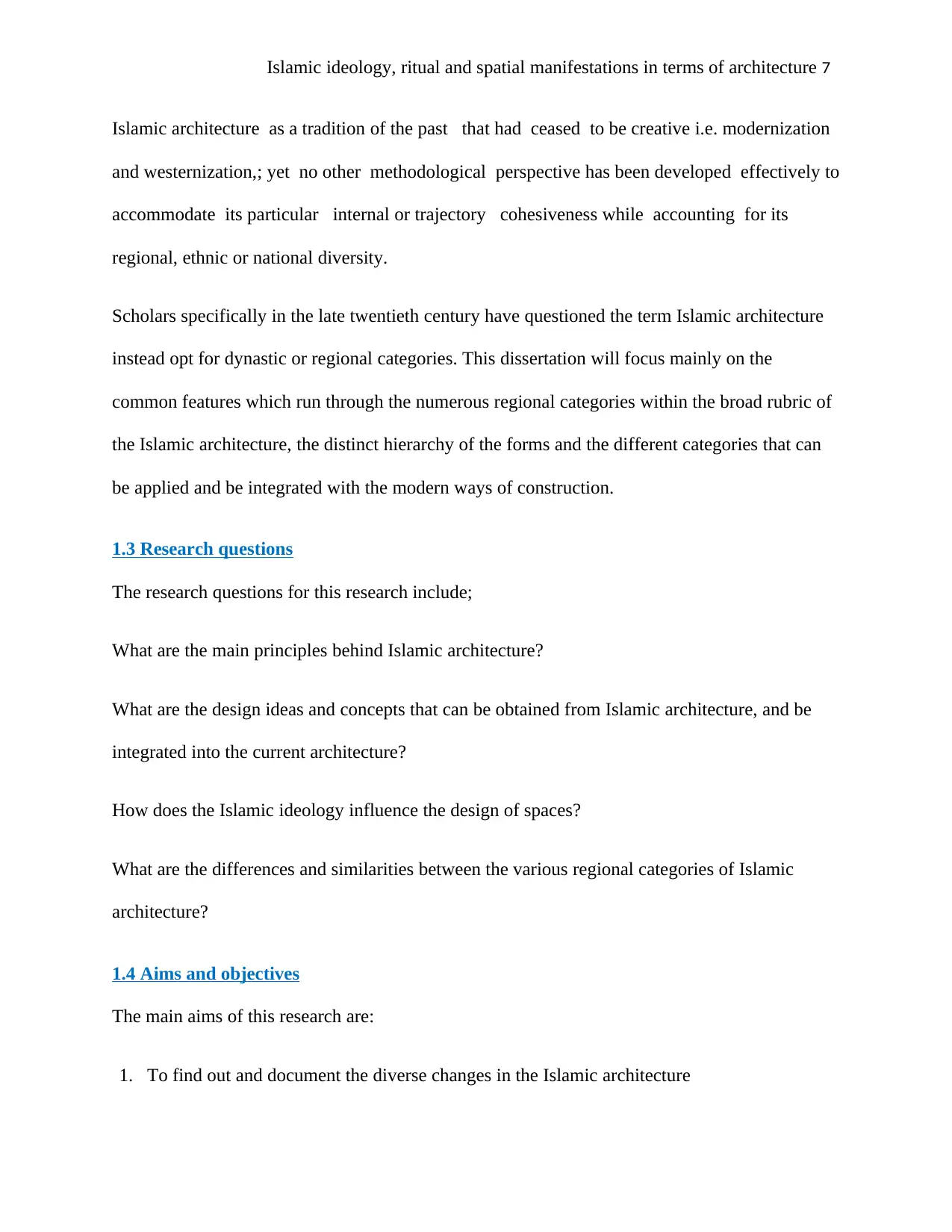
Islamic ideology, ritual and spatial manifestations in terms of architecture 7
Islamic architecture as a tradition of the past that had ceased to be creative i.e. modernization
and westernization,; yet no other methodological perspective has been developed effectively to
accommodate its particular internal or trajectory cohesiveness while accounting for its
regional, ethnic or national diversity.
Scholars specifically in the late twentieth century have questioned the term Islamic architecture
instead opt for dynastic or regional categories. This dissertation will focus mainly on the
common features which run through the numerous regional categories within the broad rubric of
the Islamic architecture, the distinct hierarchy of the forms and the different categories that can
be applied and be integrated with the modern ways of construction.
1.3 Research questions
The research questions for this research include;
What are the main principles behind Islamic architecture?
What are the design ideas and concepts that can be obtained from Islamic architecture, and be
integrated into the current architecture?
How does the Islamic ideology influence the design of spaces?
What are the differences and similarities between the various regional categories of Islamic
architecture?
1.4 Aims and objectives
The main aims of this research are:
1. To find out and document the diverse changes in the Islamic architecture
Islamic architecture as a tradition of the past that had ceased to be creative i.e. modernization
and westernization,; yet no other methodological perspective has been developed effectively to
accommodate its particular internal or trajectory cohesiveness while accounting for its
regional, ethnic or national diversity.
Scholars specifically in the late twentieth century have questioned the term Islamic architecture
instead opt for dynastic or regional categories. This dissertation will focus mainly on the
common features which run through the numerous regional categories within the broad rubric of
the Islamic architecture, the distinct hierarchy of the forms and the different categories that can
be applied and be integrated with the modern ways of construction.
1.3 Research questions
The research questions for this research include;
What are the main principles behind Islamic architecture?
What are the design ideas and concepts that can be obtained from Islamic architecture, and be
integrated into the current architecture?
How does the Islamic ideology influence the design of spaces?
What are the differences and similarities between the various regional categories of Islamic
architecture?
1.4 Aims and objectives
The main aims of this research are:
1. To find out and document the diverse changes in the Islamic architecture
Paraphrase This Document
Need a fresh take? Get an instant paraphrase of this document with our AI Paraphraser
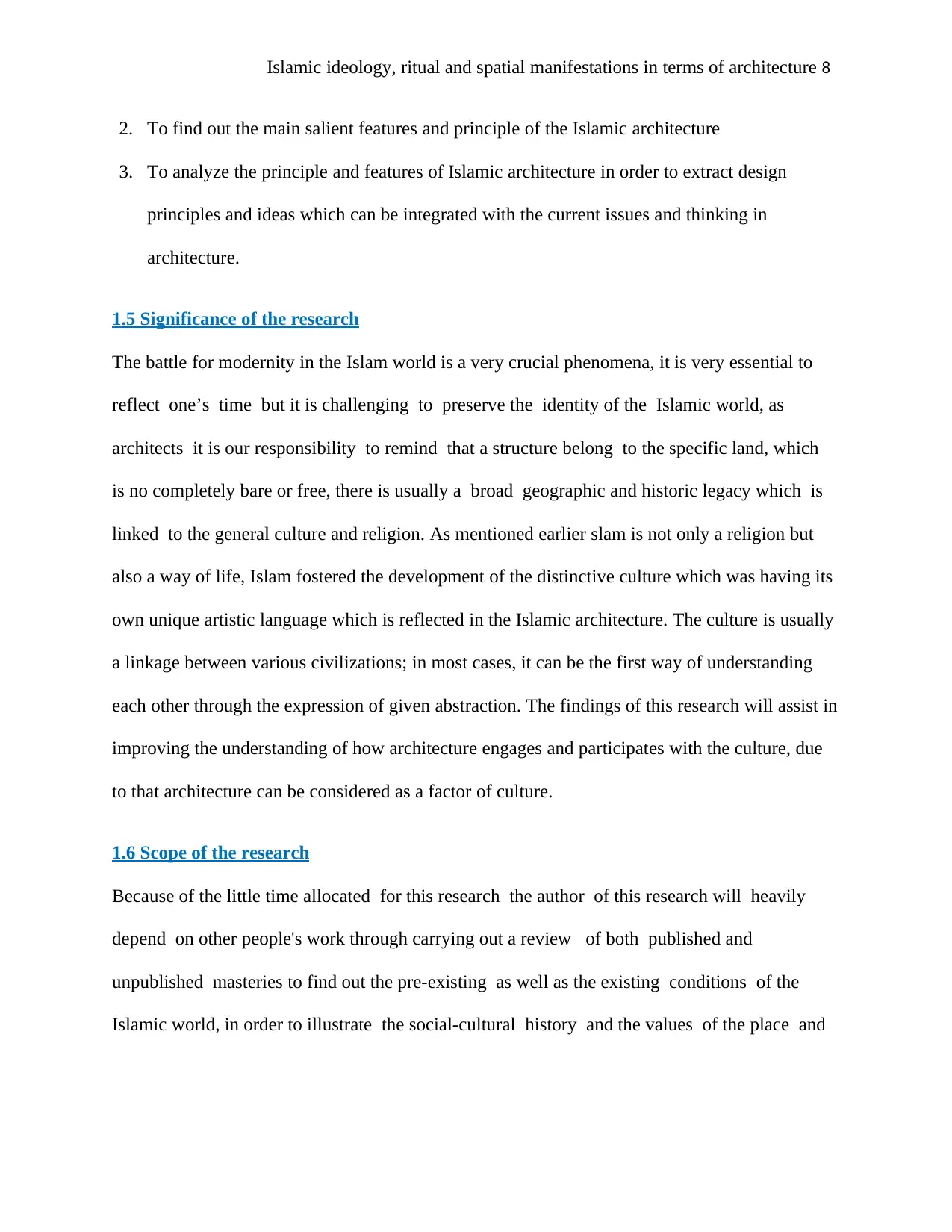
Islamic ideology, ritual and spatial manifestations in terms of architecture 8
2. To find out the main salient features and principle of the Islamic architecture
3. To analyze the principle and features of Islamic architecture in order to extract design
principles and ideas which can be integrated with the current issues and thinking in
architecture.
1.5 Significance of the research
The battle for modernity in the Islam world is a very crucial phenomena, it is very essential to
reflect one’s time but it is challenging to preserve the identity of the Islamic world, as
architects it is our responsibility to remind that a structure belong to the specific land, which
is no completely bare or free, there is usually a broad geographic and historic legacy which is
linked to the general culture and religion. As mentioned earlier slam is not only a religion but
also a way of life, Islam fostered the development of the distinctive culture which was having its
own unique artistic language which is reflected in the Islamic architecture. The culture is usually
a linkage between various civilizations; in most cases, it can be the first way of understanding
each other through the expression of given abstraction. The findings of this research will assist in
improving the understanding of how architecture engages and participates with the culture, due
to that architecture can be considered as a factor of culture.
1.6 Scope of the research
Because of the little time allocated for this research the author of this research will heavily
depend on other people's work through carrying out a review of both published and
unpublished masteries to find out the pre-existing as well as the existing conditions of the
Islamic world, in order to illustrate the social-cultural history and the values of the place and
2. To find out the main salient features and principle of the Islamic architecture
3. To analyze the principle and features of Islamic architecture in order to extract design
principles and ideas which can be integrated with the current issues and thinking in
architecture.
1.5 Significance of the research
The battle for modernity in the Islam world is a very crucial phenomena, it is very essential to
reflect one’s time but it is challenging to preserve the identity of the Islamic world, as
architects it is our responsibility to remind that a structure belong to the specific land, which
is no completely bare or free, there is usually a broad geographic and historic legacy which is
linked to the general culture and religion. As mentioned earlier slam is not only a religion but
also a way of life, Islam fostered the development of the distinctive culture which was having its
own unique artistic language which is reflected in the Islamic architecture. The culture is usually
a linkage between various civilizations; in most cases, it can be the first way of understanding
each other through the expression of given abstraction. The findings of this research will assist in
improving the understanding of how architecture engages and participates with the culture, due
to that architecture can be considered as a factor of culture.
1.6 Scope of the research
Because of the little time allocated for this research the author of this research will heavily
depend on other people's work through carrying out a review of both published and
unpublished masteries to find out the pre-existing as well as the existing conditions of the
Islamic world, in order to illustrate the social-cultural history and the values of the place and
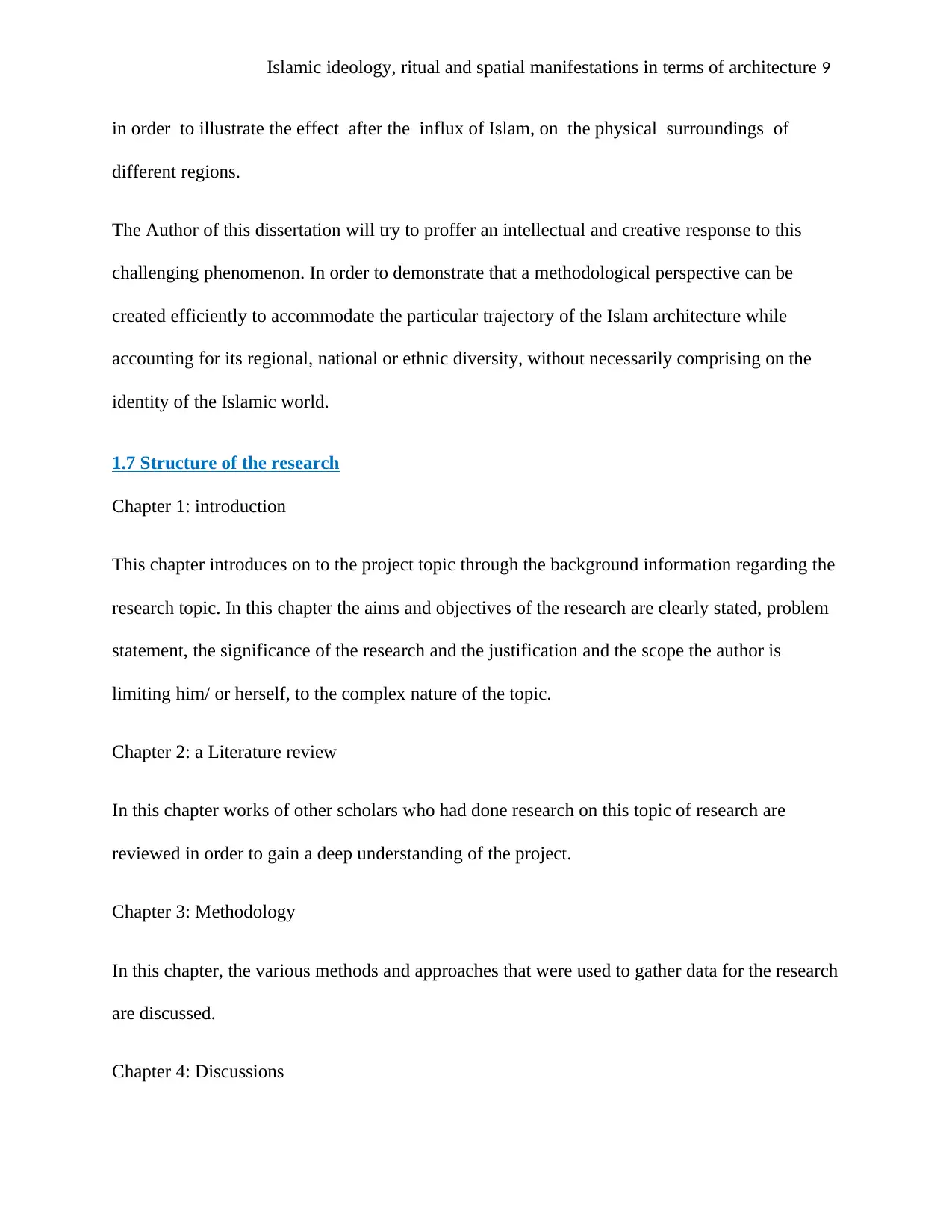
Islamic ideology, ritual and spatial manifestations in terms of architecture 9
in order to illustrate the effect after the influx of Islam, on the physical surroundings of
different regions.
The Author of this dissertation will try to proffer an intellectual and creative response to this
challenging phenomenon. In order to demonstrate that a methodological perspective can be
created efficiently to accommodate the particular trajectory of the Islam architecture while
accounting for its regional, national or ethnic diversity, without necessarily comprising on the
identity of the Islamic world.
1.7 Structure of the research
Chapter 1: introduction
This chapter introduces on to the project topic through the background information regarding the
research topic. In this chapter the aims and objectives of the research are clearly stated, problem
statement, the significance of the research and the justification and the scope the author is
limiting him/ or herself, to the complex nature of the topic.
Chapter 2: a Literature review
In this chapter works of other scholars who had done research on this topic of research are
reviewed in order to gain a deep understanding of the project.
Chapter 3: Methodology
In this chapter, the various methods and approaches that were used to gather data for the research
are discussed.
Chapter 4: Discussions
in order to illustrate the effect after the influx of Islam, on the physical surroundings of
different regions.
The Author of this dissertation will try to proffer an intellectual and creative response to this
challenging phenomenon. In order to demonstrate that a methodological perspective can be
created efficiently to accommodate the particular trajectory of the Islam architecture while
accounting for its regional, national or ethnic diversity, without necessarily comprising on the
identity of the Islamic world.
1.7 Structure of the research
Chapter 1: introduction
This chapter introduces on to the project topic through the background information regarding the
research topic. In this chapter the aims and objectives of the research are clearly stated, problem
statement, the significance of the research and the justification and the scope the author is
limiting him/ or herself, to the complex nature of the topic.
Chapter 2: a Literature review
In this chapter works of other scholars who had done research on this topic of research are
reviewed in order to gain a deep understanding of the project.
Chapter 3: Methodology
In this chapter, the various methods and approaches that were used to gather data for the research
are discussed.
Chapter 4: Discussions
⊘ This is a preview!⊘
Do you want full access?
Subscribe today to unlock all pages.

Trusted by 1+ million students worldwide
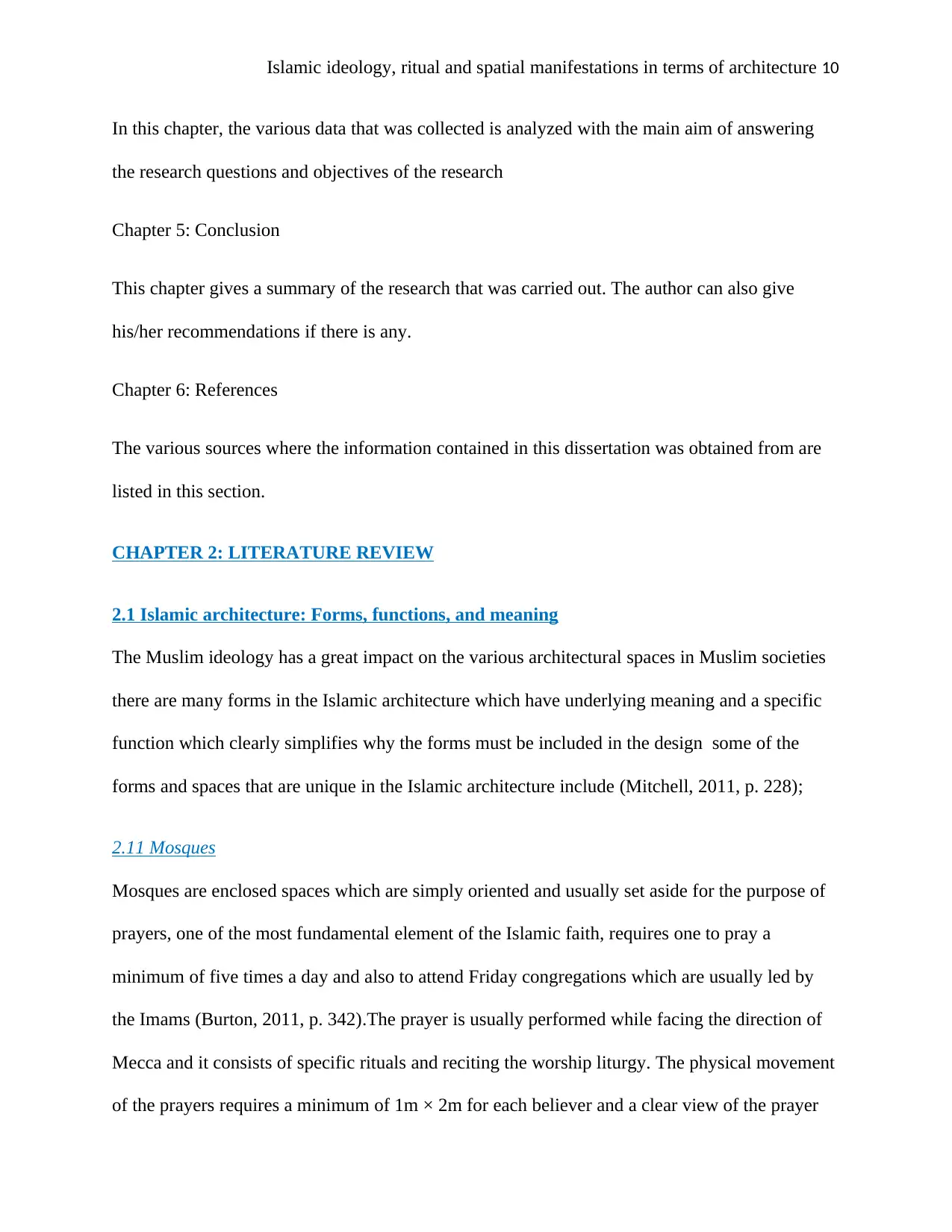
Islamic ideology, ritual and spatial manifestations in terms of architecture 10
In this chapter, the various data that was collected is analyzed with the main aim of answering
the research questions and objectives of the research
Chapter 5: Conclusion
This chapter gives a summary of the research that was carried out. The author can also give
his/her recommendations if there is any.
Chapter 6: References
The various sources where the information contained in this dissertation was obtained from are
listed in this section.
CHAPTER 2: LITERATURE REVIEW
2.1 Islamic architecture: Forms, functions, and meaning
The Muslim ideology has a great impact on the various architectural spaces in Muslim societies
there are many forms in the Islamic architecture which have underlying meaning and a specific
function which clearly simplifies why the forms must be included in the design some of the
forms and spaces that are unique in the Islamic architecture include (Mitchell, 2011, p. 228);
2.11 Mosques
Mosques are enclosed spaces which are simply oriented and usually set aside for the purpose of
prayers, one of the most fundamental element of the Islamic faith, requires one to pray a
minimum of five times a day and also to attend Friday congregations which are usually led by
the Imams (Burton, 2011, p. 342).The prayer is usually performed while facing the direction of
Mecca and it consists of specific rituals and reciting the worship liturgy. The physical movement
of the prayers requires a minimum of 1m × 2m for each believer and a clear view of the prayer
In this chapter, the various data that was collected is analyzed with the main aim of answering
the research questions and objectives of the research
Chapter 5: Conclusion
This chapter gives a summary of the research that was carried out. The author can also give
his/her recommendations if there is any.
Chapter 6: References
The various sources where the information contained in this dissertation was obtained from are
listed in this section.
CHAPTER 2: LITERATURE REVIEW
2.1 Islamic architecture: Forms, functions, and meaning
The Muslim ideology has a great impact on the various architectural spaces in Muslim societies
there are many forms in the Islamic architecture which have underlying meaning and a specific
function which clearly simplifies why the forms must be included in the design some of the
forms and spaces that are unique in the Islamic architecture include (Mitchell, 2011, p. 228);
2.11 Mosques
Mosques are enclosed spaces which are simply oriented and usually set aside for the purpose of
prayers, one of the most fundamental element of the Islamic faith, requires one to pray a
minimum of five times a day and also to attend Friday congregations which are usually led by
the Imams (Burton, 2011, p. 342).The prayer is usually performed while facing the direction of
Mecca and it consists of specific rituals and reciting the worship liturgy. The physical movement
of the prayers requires a minimum of 1m × 2m for each believer and a clear view of the prayer
Paraphrase This Document
Need a fresh take? Get an instant paraphrase of this document with our AI Paraphraser
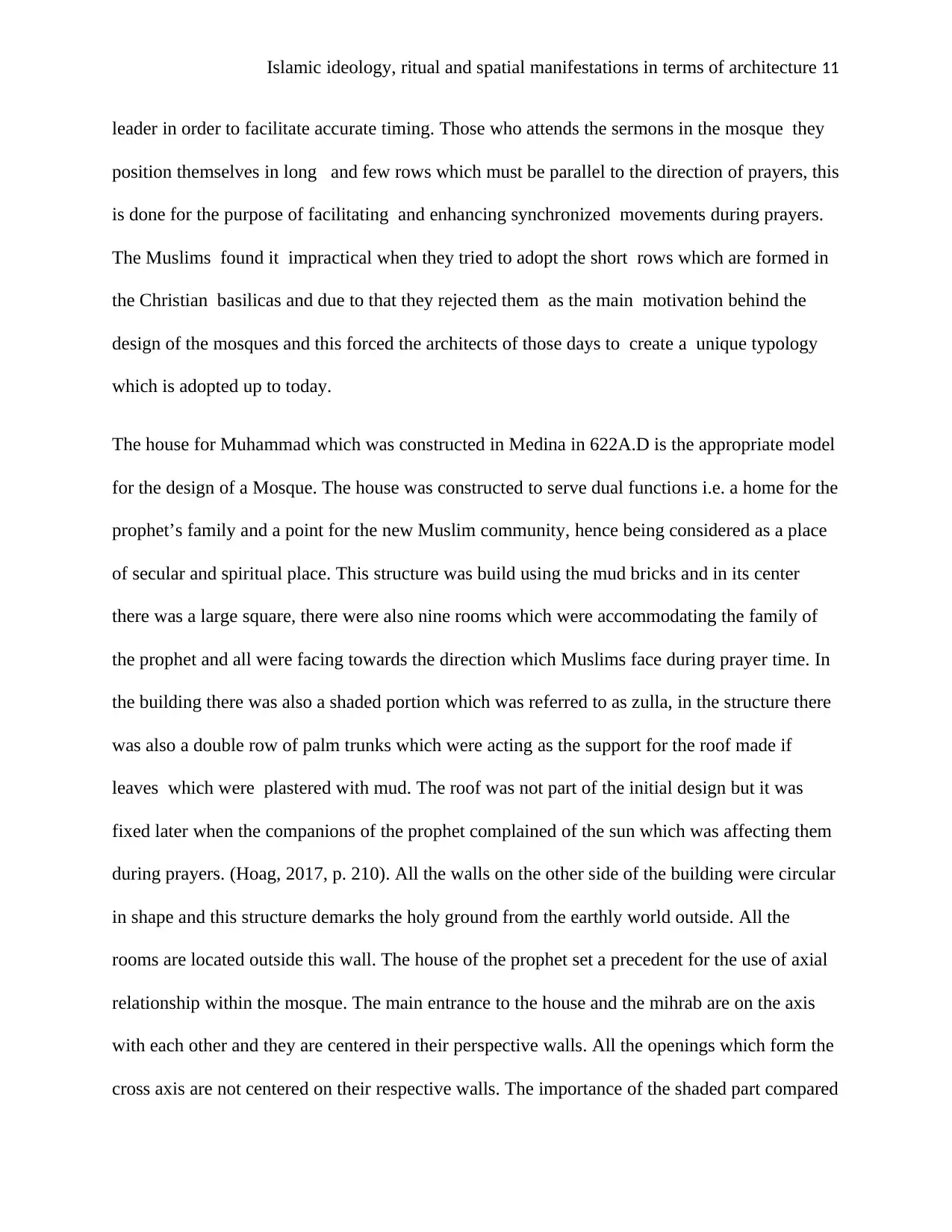
Islamic ideology, ritual and spatial manifestations in terms of architecture 11
leader in order to facilitate accurate timing. Those who attends the sermons in the mosque they
position themselves in long and few rows which must be parallel to the direction of prayers, this
is done for the purpose of facilitating and enhancing synchronized movements during prayers.
The Muslims found it impractical when they tried to adopt the short rows which are formed in
the Christian basilicas and due to that they rejected them as the main motivation behind the
design of the mosques and this forced the architects of those days to create a unique typology
which is adopted up to today.
The house for Muhammad which was constructed in Medina in 622A.D is the appropriate model
for the design of a Mosque. The house was constructed to serve dual functions i.e. a home for the
prophet’s family and a point for the new Muslim community, hence being considered as a place
of secular and spiritual place. This structure was build using the mud bricks and in its center
there was a large square, there were also nine rooms which were accommodating the family of
the prophet and all were facing towards the direction which Muslims face during prayer time. In
the building there was also a shaded portion which was referred to as zulla, in the structure there
was also a double row of palm trunks which were acting as the support for the roof made if
leaves which were plastered with mud. The roof was not part of the initial design but it was
fixed later when the companions of the prophet complained of the sun which was affecting them
during prayers. (Hoag, 2017, p. 210). All the walls on the other side of the building were circular
in shape and this structure demarks the holy ground from the earthly world outside. All the
rooms are located outside this wall. The house of the prophet set a precedent for the use of axial
relationship within the mosque. The main entrance to the house and the mihrab are on the axis
with each other and they are centered in their perspective walls. All the openings which form the
cross axis are not centered on their respective walls. The importance of the shaded part compared
leader in order to facilitate accurate timing. Those who attends the sermons in the mosque they
position themselves in long and few rows which must be parallel to the direction of prayers, this
is done for the purpose of facilitating and enhancing synchronized movements during prayers.
The Muslims found it impractical when they tried to adopt the short rows which are formed in
the Christian basilicas and due to that they rejected them as the main motivation behind the
design of the mosques and this forced the architects of those days to create a unique typology
which is adopted up to today.
The house for Muhammad which was constructed in Medina in 622A.D is the appropriate model
for the design of a Mosque. The house was constructed to serve dual functions i.e. a home for the
prophet’s family and a point for the new Muslim community, hence being considered as a place
of secular and spiritual place. This structure was build using the mud bricks and in its center
there was a large square, there were also nine rooms which were accommodating the family of
the prophet and all were facing towards the direction which Muslims face during prayer time. In
the building there was also a shaded portion which was referred to as zulla, in the structure there
was also a double row of palm trunks which were acting as the support for the roof made if
leaves which were plastered with mud. The roof was not part of the initial design but it was
fixed later when the companions of the prophet complained of the sun which was affecting them
during prayers. (Hoag, 2017, p. 210). All the walls on the other side of the building were circular
in shape and this structure demarks the holy ground from the earthly world outside. All the
rooms are located outside this wall. The house of the prophet set a precedent for the use of axial
relationship within the mosque. The main entrance to the house and the mihrab are on the axis
with each other and they are centered in their perspective walls. All the openings which form the
cross axis are not centered on their respective walls. The importance of the shaded part compared
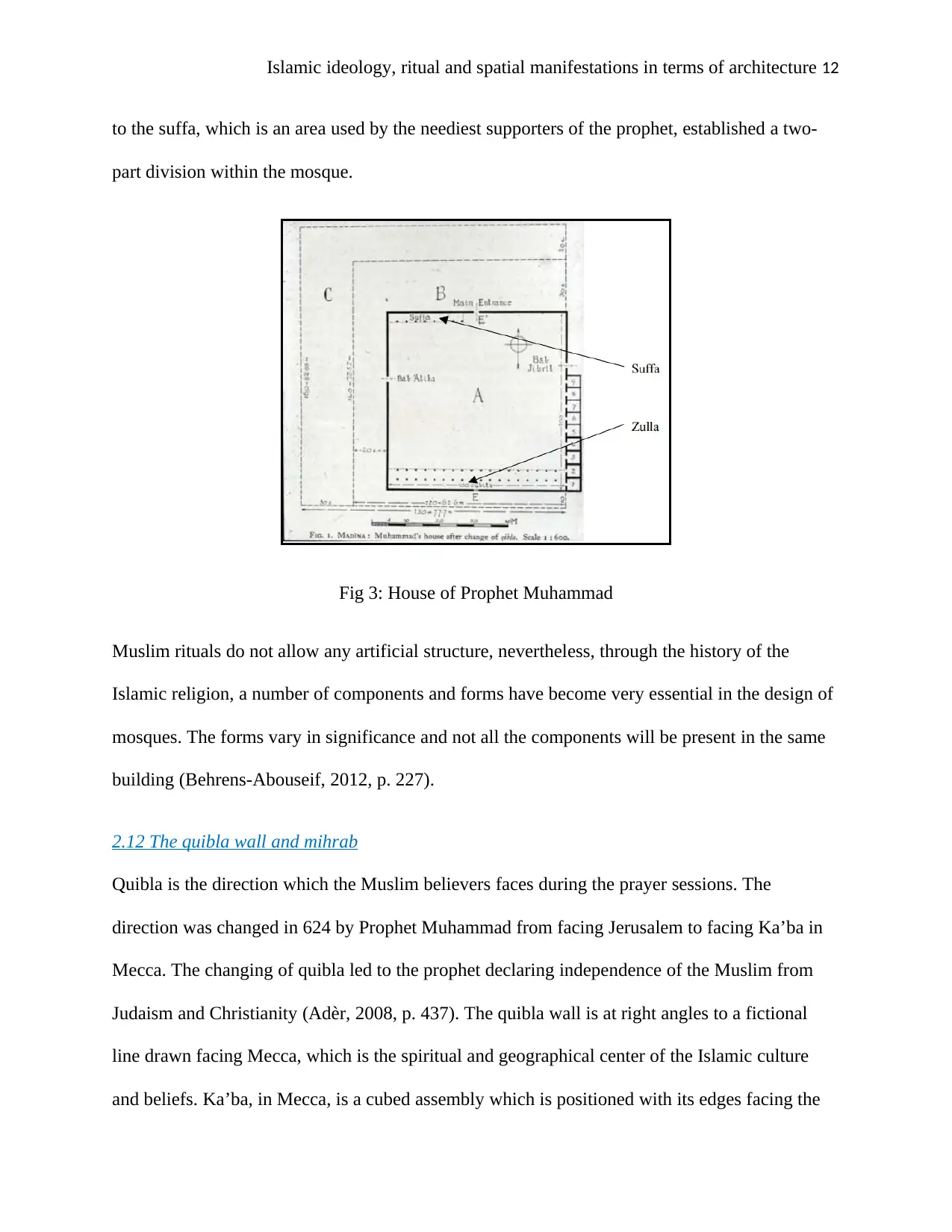
Islamic ideology, ritual and spatial manifestations in terms of architecture 12
to the suffa, which is an area used by the neediest supporters of the prophet, established a two-
part division within the mosque.
Fig 3: House of Prophet Muhammad
Muslim rituals do not allow any artificial structure, nevertheless, through the history of the
Islamic religion, a number of components and forms have become very essential in the design of
mosques. The forms vary in significance and not all the components will be present in the same
building (Behrens-Abouseif, 2012, p. 227).
2.12 The quibla wall and mihrab
Quibla is the direction which the Muslim believers faces during the prayer sessions. The
direction was changed in 624 by Prophet Muhammad from facing Jerusalem to facing Ka’ba in
Mecca. The changing of quibla led to the prophet declaring independence of the Muslim from
Judaism and Christianity (Adèr, 2008, p. 437). The quibla wall is at right angles to a fictional
line drawn facing Mecca, which is the spiritual and geographical center of the Islamic culture
and beliefs. Ka’ba, in Mecca, is a cubed assembly which is positioned with its edges facing the
to the suffa, which is an area used by the neediest supporters of the prophet, established a two-
part division within the mosque.
Fig 3: House of Prophet Muhammad
Muslim rituals do not allow any artificial structure, nevertheless, through the history of the
Islamic religion, a number of components and forms have become very essential in the design of
mosques. The forms vary in significance and not all the components will be present in the same
building (Behrens-Abouseif, 2012, p. 227).
2.12 The quibla wall and mihrab
Quibla is the direction which the Muslim believers faces during the prayer sessions. The
direction was changed in 624 by Prophet Muhammad from facing Jerusalem to facing Ka’ba in
Mecca. The changing of quibla led to the prophet declaring independence of the Muslim from
Judaism and Christianity (Adèr, 2008, p. 437). The quibla wall is at right angles to a fictional
line drawn facing Mecca, which is the spiritual and geographical center of the Islamic culture
and beliefs. Ka’ba, in Mecca, is a cubed assembly which is positioned with its edges facing the
⊘ This is a preview!⊘
Do you want full access?
Subscribe today to unlock all pages.

Trusted by 1+ million students worldwide
1 out of 34
Related Documents
Your All-in-One AI-Powered Toolkit for Academic Success.
+13062052269
info@desklib.com
Available 24*7 on WhatsApp / Email
![[object Object]](/_next/static/media/star-bottom.7253800d.svg)
Unlock your academic potential
Copyright © 2020–2025 A2Z Services. All Rights Reserved. Developed and managed by ZUCOL.




